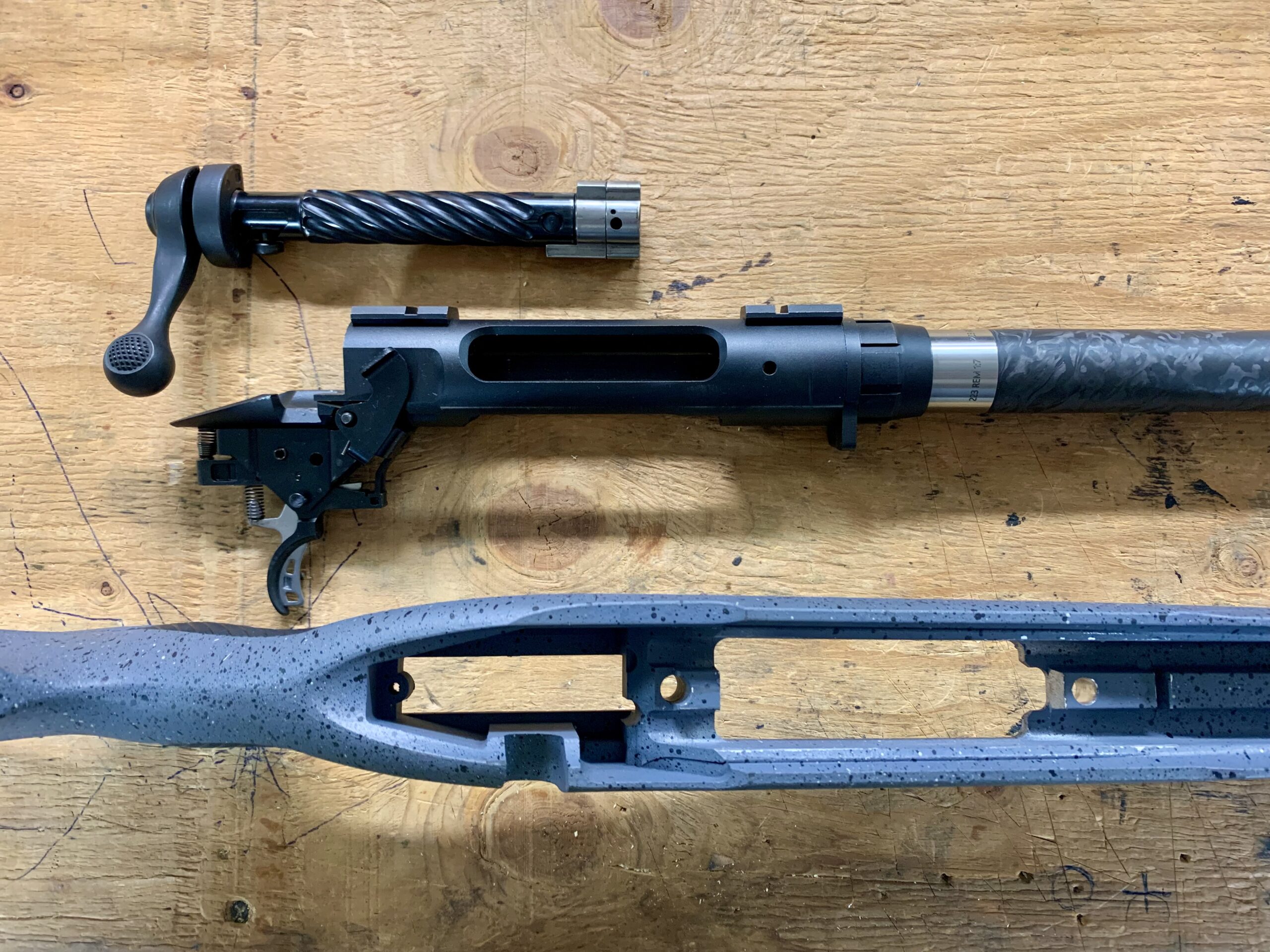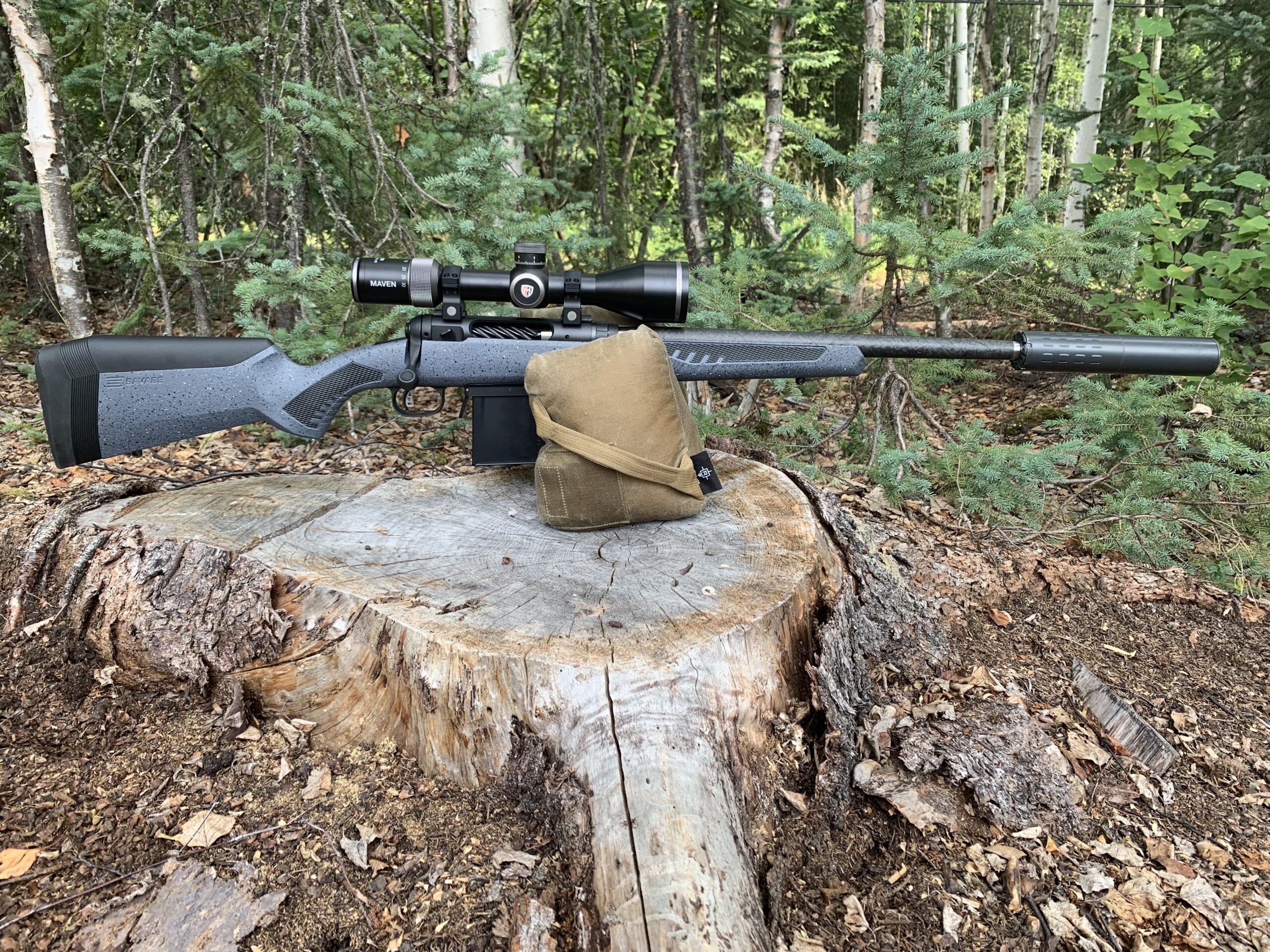We may earn revenue from the products available on this page and participate in affiliate programs. Learn More ›
The Savage Model 110 was first introduced in 1958, and it’s since been a steadfast platform for the company. Despite some faults, they’ve maintained a reputation for being accurate, reliable, and affordable. The robust M110 action has been adapted to many rifle styles and calibers, and last year, Savage introduced the Model 110 Carbon Predator. This is one of the higher-end Model 110s, and features a Proof Research carbon-wrapped barrel, Savage’s Accustock, and uses a detachable AICS-pattern magazine. The rifle is available in a variety of calibers including .223, .22-250, 6mm ARC, 6.5 Creedmoor, and .308 Win.
The supply train can sometimes move slowly, and I was disappointed to not have received my sample—chambered in .223—in time to use it for my 5.56mm and .223 ammo test earlier this spring. Still, I set it up, took it to the range, and my heart skipped a beat when the first group, with my last five rounds of Federal Gold Medal Match 69-grain ammunition printed .378 inches. Excited as I was, I had to wonder if this was just a lucky random cluster in the gun’s normal dispersion, or if this rifle was a real zinger.
- Cartridge: .223 Remington
- Capacity: 10+1, detachable AICS-pattern box magazine
- Weight: 6 pounds, 13 ounces (measured, without magazine)
- Receiver: Carbon steel
- Receiver Finish: Matte black
- Action: Two-lug bolt action
- Barrel: 18-inch, Proof Research carbon-wrapped stainless, 1:7 twist
- Muzzle: Threaded, ½-inch x 28
- Optics Mounting: Two-piece, Weaver-style bases
- Stock: Savage Accustock, composite, with bedding block
- Overall Length: 38.5 inches (measured)
- Trigger: Curved shoe, two-stage, 5 pounds, 12 ounces (measured)
- Price: $1,580
Breaking Down the Savage Model 110 Carbon Predator
We’ve written a lot about the Model 110 over the years, and featured a more modest variation in our mid-priced hunting rifles test last fall, so a lot of the Carbon Predator’s features will be familiar to anyone experienced with the series. However, this model sits at the high end of the M110 spectrum, and has a slightly different feature set. Some of it’s good, some of it isn’t.
Model 110 Carbon Predator Action and Magazine
A big departure from a lot of other M110 models is the Carbon Predator’s use of an AICS detachable magazine. It’s released by a long, narrow, spring-loaded paddle just forward of the trigger guard. The mag can be removed and installed quickly and easily with one hand, and seems like a great fit for a predator or light competition rifle. In the .223 I have, the magazine holds 10 rounds and has a full .308-sized body with a plastic insert to adapt to the smaller .223 cartridge.
Like other Model 110s with detachable magazines, this model has a closed-top, tubular magazine with an ejection port. The carbon steel receiver is thick and rigid, with a recoil lug ring sandwiched between the receiver and barrel nut. The two-lug bolt on the M110 Carbon Predator has a deeply-fluted body, and the bolt is guided in the action by a two-lug block, located just behind the actual bolt lugs. This block stays in the bolt lug channels while the bolt lugs rotate into battery when the bolt is closed. This floating bolt design is why the M110 action can feel sloppier than some others.

Magazine Issues
Although the M110 action is relatively stiff-cocking and generally not smooth, most are very reliable. With the AICS magazine however, I encountered a lot of feeding issues. Most commonly, the bolt would not catch the top round in the magazine when cycling. It would sometimes take repeated tries and manipulation of the magazine to get it working.
Another issue I encountered with various types of ammo was that the points of individual cartridges would sometimes get stuck pointing down into the magazine as I cycled the rifle and, consequently, would not feed. All ammunition was well short of magazine length. The issue seems to be caused by a lip at the top/front of the magazine. Cartridges are able to slide forward slightly under recoil and the tip of the bullet hooks under that lip, keeping the tip of the bullet pointed down into the mag.
Savage M110 Carbon Predator Stock and Trigger
Like most other modern M110’s, the Savage Model 110 Carbon Predator uses Savage’s user-adjustable Accutrigger. It consists of a curved trigger shoe and center bar which gives it a two-stage feel. Mine breaks at 2 pounds, 2 ounces, and didn’t need any adjustments.
A historic drawback of Savage rifles, in my opinion, was always the stocks—the synthetic ones anyway. They were always cheap, crooked, and had flimsy fore-ends. Although they still aren’t perfect (my barrel channel fits unevenly), Savage has improved them greatly. The Carbon Predator uses their Accustock, which is a rigid composite stock that incorporates an integrated aluminum action bedding block and an adjustable comb and length-of-pull system. The slightly palmswelled pistol grip and the fore-end both feature inlaid rubber texturing for a secure grip.
I like the sporter profile stock for a predator or truck gun type of rifle like this. It works well with a bipod or resting on bags, and resting my thumb on the wide tang, just behind the three-position safety, helps me keep a stable, consistent grip and trigger pull.

Savage Model 110 Carbon Predator: The Barrel
A well-received move on Savage’s part in recent years was to develop M110 models that use the popular Proof Research carbon-fiber-wrapped barrels. They look good, shoot well, and as shown on models like the Model 110 ultralight, they save some weight.
My sample has an 18-inch barrel that’s threaded ½-inch x 28 at the muzzle, and it makes an excellent suppressor host. I’ve been shooting it with my Silencerco Hybrid 46. Under the carbon, the barrel is stainless steel and it comes capped with a stainless knurled thread protector. The 1:7 twist isn’t necessary for any but the longest VLD .224” bullets, but it’s becoming a standard twist rate for .223 barrels.
Handling the Savage Model 110 Carbon Predator
The Carbon Predator’s 18-inch barrel makes it a nimble handler and, even with a high-power optic, it’s not too heavy to tote along between coyote-calling stands. I used a set of medium-height rings for my optic and had plenty of clearance for the bolt handle, but found that it was difficult to run the bolt without hitting the scope with my fingers.
As mentioned above, the M110 action has a stiff-cocking bolt, and it’s difficult to run smoothly. An oversized bolt handle would help that. Securely positioned behind a bipod, the action isn’t bad to run, but when shooting off bags, it’s tough to run the bolt while keeping the rifle from twisting and sliding around on the bag.

How Accurate is the Savage Model 110 Carbon Predator?
Now, I want to brag on how accurate this rifle is. I expected good accuracy from it, especially considering the quality of .223 and 5.56mm ammunition that I have to work with. I did not expect it to floor me, but it did. I have several other accurate .223 rifles, but none of them are as consistently accurate across various types of ammunition and bullet weights as this Savage proved to be. It shoots accurately, and it’s easy to shoot accurately.
In total, I recorded 33 5-shot groups using 15 different types of match and varmint ammunition with the following results:
- Overall average 5-shot group size: .65 inches
- Average group size of best 10 groups: .419 inches
This rifle shot tight groups with everything I put through it, and some loads were exceptional. Out of all 33 5-shot groups, only two exceeded one inch, and the largest recorded group was 1.197 inches. Two loads averaged sub-half-inch groups. For additional data and verification, I fired a 30-shot group at the same aiming point, in 3 10-shot strings, letting the barrel cool between. I used the most accurate-shooting ammo, Black Hills 50-grain V-Max, which averaged .463-inch 5-shot groups.
- 30-shot group size: .712 inches

Any objective observer with a lot of rifle experience will note that there aren’t many $1,500, or even $2,000 hunting rifles that can do that. When presenting accuracy averages for rifles in our gun test, OL historically averages the 10 best groups as a solid representation of a rifle’s capabilities. The best 10 groups I recorded from this Savage Model 110 Carbon Predator averaged a touch better than the .456-inch average that the Accuracy International AT-X and a number of other superb shooting rifles have punched out for us. It’s remarkable.
What the Model 110 Carbon Predator Does Well
The Savage M110 Carbon Predator has a much better stock than previous generations of M110’s and has a good adjustable trigger. More significantly, it flat-out shoots. I’d be hard-pressed to find a more accurate factory rifle than this one.
Read Next: Best BB Guns of 2023, Tested and Reviewed
Where the Model 110 Carbon Predator Could Be Better
The interface between the rifle and the Accurate Mag magazine is simply awful. I’ve encountered feeding and cycling issues on a regular basis. A different magazine would likely remedy the issue.
Final Thoughts
Superb accuracy can make up for a lot of faults in a rifle, and it’s the only thing that gives me pause when considering the disappointing function of the magazine. There are lots of good-shooting rifles that run smoothly. I’d hesitate at the prospect of using it in competition, or where rapid follow-up shots are needed. Still, it would make a great coyote or prairie dog rifle.
